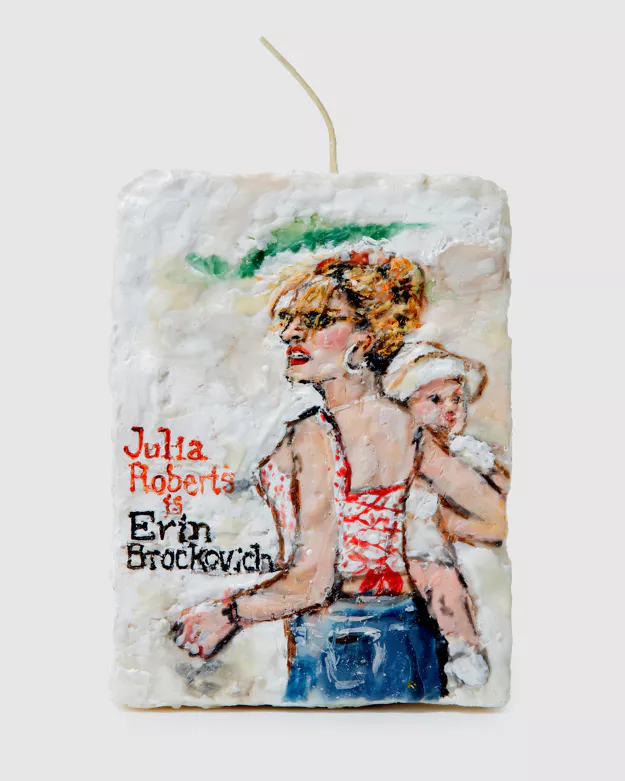About the artwork:
This print, dating from the last decade of the artist’s life, depicts a female spider with a human face, contained within an egg-shaped form. The vibrant scarlet ink is a color the artist favored in her late work.
Throughout her long career, Bourgeois turned to the motif of spiders across many different media—from drawings and prints to monumental outdoor sculptures. The theme of the spider was initially associated with the artist's mother, a tapestry restorer. Later, the symbol grew to take on broader associations as a strong female protector against evil.
For Bourgeois, art-making is both an exorcism and a tool for coping, or as the artist said: “Art is a guarantee of sanity.” After working without much recognition for several decades, Bourgeois became internationally known at the age of 70 for unique works that explore themes of loneliness, jealousy, anger and fear.
About the artist:
When she first exhibited her work, Bourgeois’s idiosyncratic approach to art-making was out of step with the formal issues dominating the art world at that time. But by the 1970s and 1980s, the artist's work was internationally recognized. Bourgeois was renowned for creating unique works, including: monumental spiders, eerie room-sized “Cells,” evocative figures often hanging from wires and a range of fabric works fashioned from her old clothes. The artist also constantly made drawings on paper and regularly returned to printmaking. For Bourgeois, art was both a tool for coping and an exorcism.
Louise Bourgeois, born in Paris, France in 1911, was raised by parents who ran a tapestry restoration business. The artist was a gifted student and also assisted her parents in the workshop by drawing missing elements in the scenes depicted on the tapestries. During this time, the artist's father carried on an affair with Sadie Gordon Richmond, the English tutor who lived in the family house. This deeply troubling—and ultimately defining—betrayal remained a vivid memory for Bourgeois for the rest of her life.
Bourgeois studied mathematics before eventually turning to art. The artist met Robert Goldwater, an American art historian, in Paris, France, and they married and moved to New York City in 1938. The couple raised three sons.
Early on, Bourgeois focused on painting and printmaking, turning to sculpture only later in the 1940s. By the 1950s and early 1960s, the artist became immersed in psychoanalysis, resulting in gaps in her production. In 1964, for an exhibition after a long hiatus, Bourgeois presented strange, organically shaped plaster sculptures that contrasted dramatically with the totemic wood pieces she had exhibited earlier. These works alternated between forms, materials and scale, veering between figuration and abstraction. This combination of elements became a basic part of Bourgeois’s artistic vision in works that probed the themes of loneliness, jealousy, anger and fear.
Louise Bourgeois: Retrospective opened at MoMA in New York City in 1982. Curated by Deborah Wye, it was MoMA’s first retrospective devoted to a female artist. In 1982, the first European retrospective of Bourgeois’s work opened at the Frankfurter Kunstverein in Frankfurt Germany, organized by Peter Weiermair. In 1980, Bourgeois had acquired a bigger studio space in Brooklyn, New York, and began creating increasingly large-scale works. In 1991, the artist showed the first of a new series of work, the Cells, at Carnegie International in Pittsburgh, Pennsylvania. A year later, Bourgeois took part in Documenta IX in Kassel, Germany. In 1993, the artist represented the United States Pavilion for the 45th Venice Biennale. In 1994, Bourgeois installed her first large-scale Spider at the Brooklyn Museum in New York.
Following a decade of international exhibitions and awards, the Tate Gallery of Modern Art in London, UK commissioned Bourgeois in 2000 for the inaugural installation of the museum’s new location at the Turbine Hall of the Bankside Power Station. The artist presented a thirty-foot steel and marble spider, Maman (1999), and conceived three steel architectural towers titled I Do, I Undo, and I Redo (1999–2000). The following ten years continued to bring Bourgeois acclaim. The artist was the subject of numerous major exhibitions, including the first showing of a living American artist at the State Hermitage Museum in St. Petersburg, Russia, curated by Julie Sylvester in 2001. In 2007, another major retrospective of Bourgeois's work was organized by the Tate Modern in London, UK and the Centre Pompidou in Paris, France. Curated by Frances Morris, Marie-Laure Bernadac and Jonas Storsve, the exhibition traveled to the Solomon R. Guggenheim Museum in New York City, the Museum of Contemporary Art in Los Angeles, California and the Hirshhorn Museum and Sculpture Garden in Washington, D.C.
Bourgeois was named Officer of the Order of Arts and Letters by the French minister of culture in 1983. Other honors included the Grand Prix National de Sculpture from the French government in 1991; the National Medal of Arts, presented by President Bill Clinton in 1997; the first lifetime achievement award from the International Sculpture Center in Washington D.C.; and election as a fellow of the American Academy of Arts and Sciences. In 2008, the French Legion of Honor medal was presented to Bourgeois by President Nicolas Sarkozy in the artist’s Chelsea home in NYC.
Bourgeois died in New York City in 2010, at the age of 98.






